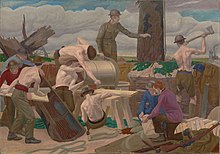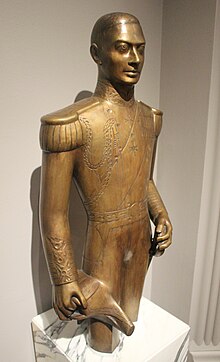Leon Underwood
Leon Underwood | |
|---|---|
Regent Street Polytechnic | |
| Known for | Sculpture, Wood-engraving |
| Spouse | Mary Coleman (m.1917) |
George Claude Leon Underwood (25 December 1890 – 9 October 1975) was a British artist, although primarily known as a sculptor, printmaker and painter, he was also an influential teacher and promotor of African art.[1][2] His travels in Mexico and West Africa had a substantial influence on his art, particularly on the representation of the human figure in his sculptures and paintings.[3] Underwood is best known for his sculptures cast in bronze, carvings in marble, stone and wood and his drawings. His lifetime's work includes a wide range of media and activities, with an expressive and technical mastery. Underwood did not hold modernism and abstraction in art in high regard and this led to critics often ignoring his work until the 1960s when he came to be viewed as an important figure in the development of modern sculpture in Britain.[4]
Biography
Early life
Underwood was born in the west London suburb of
World War I

In the
1920s and 1930s
After the war Underwood attended the
In 1922 Underwood had his first solo exhibition at the

After returning to England in late 1928 Underwood made a number of paintings on Mexican themes, including imagined portraits of
Underwood's 1937 bronze sculpture of King
World War II
From 1939 to 1942, during
Later life
From 1948 onwards, Underwood cast his bronze sculptures in his own studio and throughout the 1950s, concentrated on his sculpture and on promoting his theories and philosophy of art.[7][24] In 1961 Underwood was elected an Honorary Member of the Royal Society of Sculptors and further recognition followed in 1969 when the first full-scale retrospective of his work was held at The Minories in Colchester.[3][7] The art historian John Rothenstein wrote in the introduction to that exhibition that Underwood was "..the most versatile artist at work in Britain today..".[25] However it was to be over forty years before the next major retrospective of his work was held, in 2015 at the Pallant House Gallery.[15][9] This lack of attention has been attributed to the range and versatility of Underwood's output which, across the various media he worked in, lacked a common recognisable style that was easy to promote and also to his, sometimes, complex and esoteric philosophies and theories on art.[26]
Underwood was married to Mary Coleman. They first met in 1911 at the Royal College of Art, married in 1917 and their first child was born in 1919.[27] They had two sons, Garth (a zoologist)[28] and John, and one daughter, Jean.
Public commissions
- Tempera mural for Shell canteen London, 1954[5]
- Relief panel (a larger version of "Light Industries and Secretariat", 1953[29]) for the Commercial Development Building, 49-59 Old Street, London, EC1V 9HX, 1955[5]
- Reredos, side chapel and stained glass window, St Michael and All Angels, New Marston, Oxford, 1955[3]
- Bronze candlesticks and crucifix Ampleforth Abbey, 1958.[5]
Selected publications
- Animalia. Payson and Clarke, 1926.[16]
- The Siamese Cat. Brentano's, 1928.
- The Red Tiger, 1929, by Phillip Russell, illustrated by Underwood, an account of their joint travels in Mexico.[8][14][20]
- Art for Heaven's Sake: Notes on a Philosophy of Art, 1934[21][20]
- Figures in Wood of West Africa. Alec Tiranti, 1947.
- Masks of West Africa. Alec Tiranti, 1948.
- Bronzes of West Africa. Alec Tiranti, 1949.[9]
- Bronze Age Technology in Western Asia and Northern Europe, 1958.[3]
Museums and public collections

Public collections holding works by Underwood include
- the Courtauld Institute of Art, London[30] (39 works)
- the Tate Gallery, London[31](8 works)
- the National Portrait Gallery, London,[16] (4 works)
- the Ingram Collection, The Lightbox, Woking[32] (2 works)
- the Victoria and Albert Museum, London, archive of 206 drawings and sketches[6]
- the Ashmolean Museum, Oxford[33]
- the National Museum Cardiff[34] (two works)
- the British Council Collection, London, (five works)[23]
- Hammersmith and Fulham Archives[35] (15 works)
- The Victor Batte-Lay Trust Collection at The Minories[36] (two works)
- The Brooklyn Museum[37] (three works)
- Leamington Spa Art Gallery & Museum[38] (six works)
- the Henry Moore Institute in Leeds hold archives of Underwood's correspondence and other material.[24]
Exhibitions
- Leon Underwood, Mexican Wood engravings. St George's Gallery, 1928
- Leon Underwood, Mexican watercolours. St George's Gallery, 1929
- Sculpture, Paintings, Drawings and Engravings by Leon Underwood. Leicester Galleries, 1934
- Sculpture in the Home. Arts Council, 1946
- Leon Underwood. Beaux Arts Gallery, 1953
- Bronzes and Wood Engravings by Leon Underwood. Thomas Agnew & Sons, 1973
- Leon Underwood, Mexico and After. National Museum of Wales, 1979
- Modern British Sculpture. Royal Academy of Arts, 2011
- Mexico A revolution in art 1910-1940. Royal Academy of Arts, 2013
- The Sensory War 1914-2014. Manchester Art Gallery, 2014
- Leon Underwood, Figure and Rhythm. Pallant House Gallery, 2015[22]
- Becoming Henry Moore. Henry Moore Foundation, 2017
References
- ^ ISBN 0500090998.
- JSTOR 40793641.
- ^ ISBN 1-85149-106-6.
- ^ ISBN 0-19-860476-9.
- ^ a b c d e f g University of Glasgow History of Art / HATII (2011). "Leon Underwood". Mapping the Practice and Profession of Sculpture in Britain & Ireland 1851–1951. Retrieved 9 August 2020.
- ^ a b "Archive of Art & Design – Leon Underwood". Victoria and Albert Museum. Retrieved 8 August 2020.
- ^ ISBN 0-953260-95-X.
- ^ a b "Leon Underwood 9 July – 8 August 2013 at Redfern Gallery, London". Wall Street International Magazine. 19 July 2013. Retrieved 10 August 2020.
- ^ a b c d e f g h i j k Leif Birger Holmstedt (13 January 2019). "Leon Underwood Sculptor, Scholar and Collector". ÌMỌ̀ DÁRA. Retrieved 9 August 2020.
- ^ a b Tim Newark (2007). Camouflage. Thames and Hudson / Imperial War Museum.
- ISBN 978-1-906593-00-1.
- ^ "Erecting a Camouflage Tree". Imperial War Museum. Retrieved 8 August 2020.
- ^ a b c Simon Martin (2015). "The Portraits of Leon Underwood by Simon Martin". Understanding British Portraits. Retrieved 28 February 2023.
- ^ a b c d e f g "Leon Underwood". The British Museum. Retrieved 2 September 2020.
- ^ a b c Mark Sheerin (27 April 2015). "Leon Underwood steps out of historical shadows with major show at Pallant House". culture 24. Retrieved 12 August 2020.
- ^ a b c "Person: Leon Underwood". National Portrait Gallery. 26 December 2016. Retrieved 1 June 2017.
- ^ Celina Jeffery (2002). "The Ember (Italian Immigrant)". Tate. Retrieved 8 August 2020.
- ^ a b "Catelogue entry: Casement to Infinity (1930)". Tate. Retrieved 8 August 2020.
- ^ ISBN 9780500021828.
- ^ a b c "Leon Underwood". Redfern Gallery. Retrieved 28 February 2023.
- ^ a b c Celina Jeffery (2002). "Manitu Bird (1935)". Tate. Retrieved 8 August 2020.
- ^ a b Simon Martin (27 February 2015). "First Look: Leon Underwood at Pallant House Gallery". Apollo. Retrieved 28 February 2023.
- ^ a b c "Leon Underwood (1890–1975)". British Council. 2011. Archived from the original on 3 February 2014. Retrieved 8 August 2020.
- ^ a b "Papers of Leon Underwood". Jisc Archives Hub. Retrieved 28 February 2023.
- ^ John Rothenstein (1969). Leon Underwood a retrospective exhibition. Colchester: The Minories.
- ^ Simon Martin (2015). "Figure and Rhythm: Reassessing Leon Underwood". Port. Retrieved 12 August 2020.
- ^ "Catalogue entry: The Fireside (1919)". Tate. Retrieved 8 August 2020.
- .
- ^ "Leon Underwood, Light Industries and Secretariat, 1953 | Sculpture". The Redfern Gallery. Retrieved 29 March 2023.
- ^ "A&A Search : Leon Underwood". Artandarchitecture.org.uk. Retrieved 1 June 2017.
- ^ Celina Jeffery (2002). "Totem to the Artist (1925–30)". Tate. Retrieved 8 August 2020.
- ^ "search results". ingramcollection.com. Retrieved 1 April 2019.
- ^ "All Online Collections". Ashmolean.org. Archived from the original on 18 May 2007. Retrieved 1 June 2017.
- ^ "UNDERWOOD, Leon | Art Collections Online". Museumwales.ac.uk. Retrieved 1 June 2017.
- ^ "Brook Green Artists, 1890–1940 | LBHF Libraries". Lbhflibraries.wordpress.com. 1 July 2013. Retrieved 1 June 2017.
- ^ "Leon Underwood". The Victor Battle-Ley Trust Collection. Archived from the original on 26 July 2014. Retrieved 20 July 2014.
- ^ "Collections: Leon Underwood". Brooklyn Museum. Archived from the original on 29 July 2014. Retrieved 8 August 2020.
- ^ "Leon Underwood works". Search.woindowsonwarwickshire.org.uk. Retrieved 1 June 2017.
External links
- 37 artworks by or after Leon Underwood at the Art UK site
